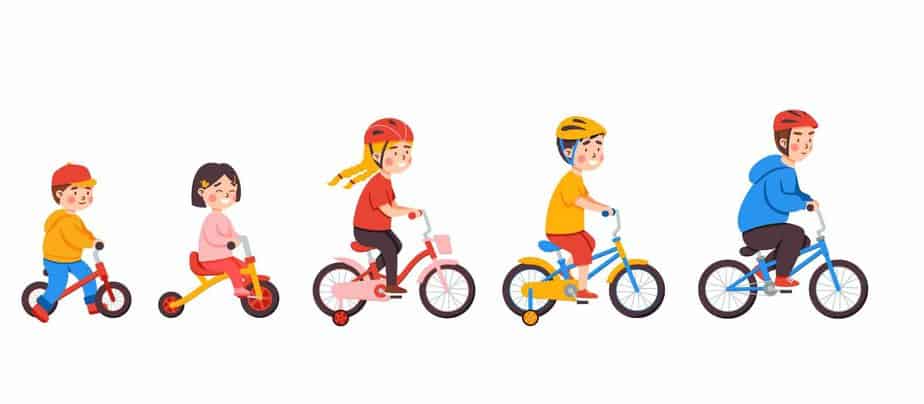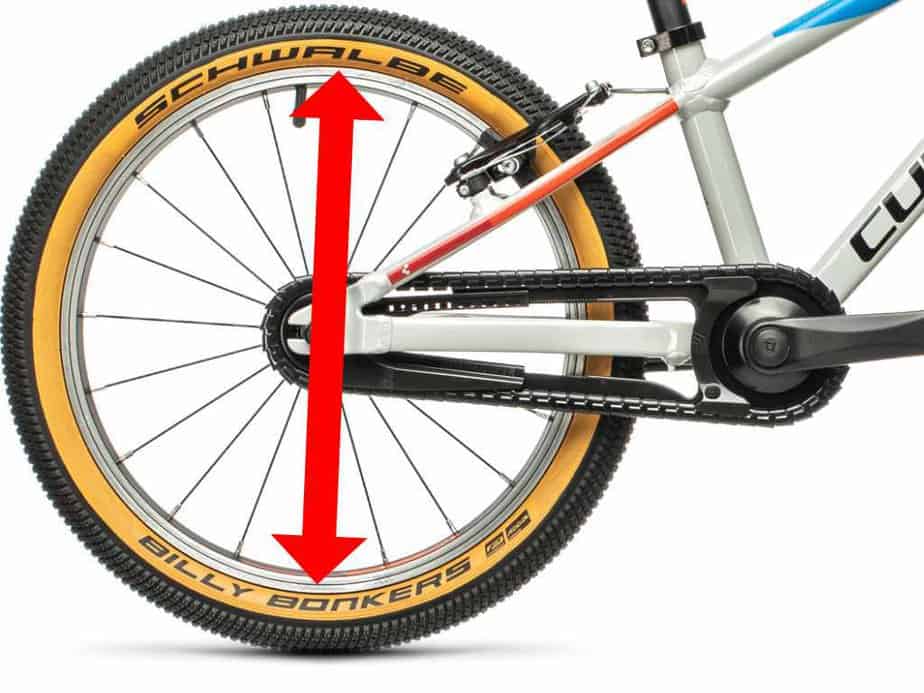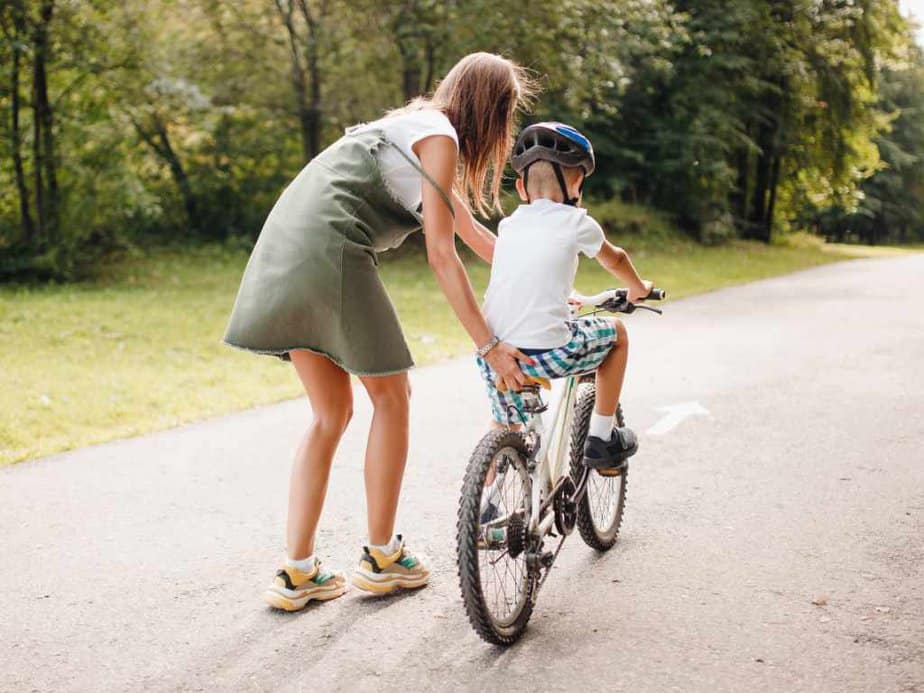Kids Bike Size Chart (Guide For Sizing Bicycles)

What Size Bike For Kids? (A Guide For Boys & Girls)
Sizing bikes for your child can be a confusing affair because of the bewildering array of bike sizes that cater to kids of all age groups.
However, this can be easily accomplished by having a basic understanding of how kids’ bicycles are sized and what to look for when deciding on the right size bike for the child.
At the same time, it bodes well for the kid to have the right-sized bike as that would play a role in how the kid perceives biking to be and lean into this wonderful experience.
A good experience with bikes and biking in the early years is crucial for the child to develop an appreciation for this activity and the outdoors.
This would help keep the kid fit instead of clamming up inside the house and engaging in sedentary activities.
How Are Kids Bike Sized?
Kids’ bikes are sized based on the wheel size, unlike adults’ bikes which are sized based on the frame as well as the wheel size.
The wheel size is the measurement of the diameter of the wheels.

For eg., a 20-inch bike for kids denotes the diameter of the wheels which measure 20 inches from one point on the wheel to another point that lies exactly opposite to it.

What Size Bike For Child?
Although kid’s bikes are denoted by the wheel size, take that only as a general guideline when bike sizing for your kid.
A better gauge would be the age and height of the child.
As kids can vary very much in terms of their height and weight for the same age, going with wheel size as the metric may not be an ideal method to select the right bike.
Also, factor in the growth spurt of the child as otherwise you would find yourself in the market for a new bike in a couple of months’ time. Kids can grow out of the bikes before they get to grow into their bikes.
The below bike size chart gives a suitable estimation of the recommended height and age for all kids’ bike wheel sizes.
Bike Size Chart:
| Bike Wheel Size | Height (Inches) | Age (Years) |
| 10 Inch | Toddler | 2 – 3 |
| 12 Inch | 34” – 40” | 3 |
| 14 Inch | 36” – 42” | 3 – 4 |
| 16 Inch | 36” – 46” | 4 – 5 |
| 18 Inch | 40” – 50” | 5 – 6 |
| 20 Inch | 43” – 55” | 6 – 7 |
| 24 Inch | 51” – 59” | 8 – 9 |
| 26 Inch | 58” – 63” | 10 – 13 |

Boys And Girls Bike Size Difference:
From a functional aspect, there is no difference between girls’ and boys’ bikes other than that of aesthetics.
Both boys and girls can ride the same bike. It’s mostly a marketing gimmick where you’ll get to see girls’ bikes where the only difference would be in terms of the color palette of the bike and some additional accessories like baskets etc.
Some bikes may sport a lowered top tube on girls’ bikes which makes it easier for the child to hop on and out of the bike.

Factors To Consider When Selecting A Bike Size For The Child:
Weight Of The Bike:
The weight of the bike is an important factor that can play a big role in how the child experiences the bike and is something that is overlooked by adults when purchasing a bike for the kids.
A kid’s physique is not developed well enough, unlike adults, to lug around weights that are heavy in proportion to their body weight.
So a slight increase in weight can translate into a big effort for the child.
The materials used on the bike are the major factor. Steel tends to be heavier than aluminum and can add weight to the bike.
Carbon fiber is the lightest but is expensive and is mostly found on high-end performance bikes.
Likewise, aluminum is costlier than steel and is also less prone to rusting.
Bikes from the big box retail brands that are cheap tend to be heavy and unwieldy.
Extra features such as gearing can also add to the weight of the bike.
The Fit & Geometry Of The Bike:
The fit & geometry of the bike is also a factor that needs to be taken into account when sizing a bike for kids.
Bikes with poor geometry such as that found on the big box retail brands can play spoilsport and ruin the fun of biking for the child.
There are a couple of aspects of geometry that can be broken down into
- Standover Height
- Reach & Stack
- Q-Factor
Standover Height:
This is the measurement of the height of the bike from the floor to the top tube (the tube that connects the seat post to the front of the bike near the fork).
This distance from the floor to the top tube indicates how much room the kid has when standing over the bike.
Ideally, this gap should be a couple of inches more than the standover height of the child.
This optimum height imparts confidence to the kid, especially when they are learning to bike.
Reach & Stack:
Reach & Stack roughly refers to the space between the triangular frame of the bike – between the saddle at the back, the fork in the front, and the bottom bracket at the bottom (the part where the cranks are attached).

This space has to be optimum for the rider to feel confident and comfortable with the bike.
Too much space and the child will be seated way back on the saddle and would feel less confident with the handling.
Too little space and the kid would feel cramped resulting in overexertion to propel the bike forward which may also result in the knee touching the handlebars during the top of the stroke.
Q-Factor:
This is the distance between the two pedals, roughly denoting the width of the bike. The lower the Q factor the better the balance.
As the Q factor increases, the kid will have to splay the legs while pedaling resulting in overexertion.
Bonus Factors To Look Into When Choosing a Kids Bike
There are a number of things to take into account when picking out a kid’s bike to make sure your child receives the ideal bike for their needs. When looking for a kid’s bike, keep the following factors in mind:
Age and skill level:
The proper bike size and style will be heavily influenced by your child’s age and ability. For instance, younger kids might benefit more from a bike with bigger wheels and a more upright riding position, while older kids might prefer a bike with smaller wheels and a more aggressive riding position.
Size and weight:
Choosing a bike that is the proper size for your youngster is crucial. A bike that is too small will be challenging to control and ride, while a bike that is too large could be heavy and challenging to handle. Measure your child’s inseam and compare it to the size chart provided by the bike manufacturer to get the appropriate size.
Type of Terrain:
Your choice of bike will also depend on the kind of terrain your child will be riding on. A bike with road tires can be an excellent option if they want to ride mainly on smooth, paved surfaces. A bike with wider, knobbier tires might be better suited for off-road riding.
Brake Type:
The type of brakes on the bike should be taken into account. Younger kids might find it simpler to utilize coaster brakes, which are operated by pedaling backward. Children may be ready for bikes with hand brakes as they get older and more proficient.
Adjustability:
Children will require a bike that can be changed as they grow to accommodate their changing sizes. Seek out bicycles with adjustable handlebars and seat heights, as well as easily replaceable parts like tires and pedals.
Durability:
Choosing a model that is made to last is vital because kids can be rough on their bikes. A good guarantee and sturdy frames and components are things to look for in bicycles.
Price:
Lastly, when looking for a kid’s bike, think about your budget. While it’s crucial to spend money on a high-quality, long-lasting bike, you don’t want to go overboard. Look for a bike that offers a nice mix of value and performance.
By considering these factors, you can be confident that you are choosing the best bike for your child’s needs. Your child will have a lot of fun riding and honing their cycling skills on a bike that is the right size, appropriate for the terrain they will be riding on, and built to last.
